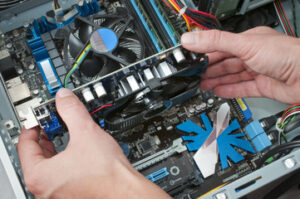Computer Repair technicians take malfunctioning hardware and software and perform the necessary steps to return it to a usable state. These professionals work in a variety of settings, including repair centers, businesses, healthcare organizations, and schools.

Aside from knowledge of computers and their hardware and software, these technicians also need problem-solving and logic skills. They may also earn certifications to demonstrate their industry expertise and exemplary technical skills.
Troubleshooting is a process that allows computer users to resolve issues and errors that occur within their computer or software system. It also enables the repair and restoration of computers that have become faulty or unresponsive.
When your computer starts acting up, it can be a frustrating experience, especially when you’re trying to do something productive. Luckily, there are several simple techniques that can help you get your computer back on track.
First, you should try to narrow down the problem as much as possible. This can be done by determining when the issue began or what caused it to start occurring. Think about when you last used your computer or if you’ve made any changes to the hardware or software on your computer recently.
Once you’ve ruled out as many potential causes as you can, it’s time to begin the actual troubleshooting phase. This can be a long and tedious process, but it will pay off in the end.
As you work to establish what the problem is, it’s a good idea to use focused experimentation. This can involve resetting your computer, changing settings related to the issue, swapping out faulty parts, or repairing corrupted files.
If your problem remains, you may need to take your computer to a professional for a more thorough evaluation. Once they’ve ruled out as many problems as possible, they will be able to help you figure out what is going wrong and find the best solution.
This is especially important if the problem has been ongoing for a while or if you’ve recently added new components to your computer. You’ll want to be sure that these are compatible with your system, or else the new component will cause your computer to malfunction again.
The best way to ensure you are taking the right steps to fix your problem is by documenting everything you do. This can be done by writing down what you did and any error messages you received. This will help you to keep track of what steps you took and also make it easier for other people to help you if the issue occurs again.
Computer hardware refers to the physical parts that make up a computer. It includes everything from the CPU to the mouse and keyboard. It also covers things like the graphics card and the sound card, which are all necessary for a computer to work effectively.
All of these components are delicate, and if they’re not properly taken care of, they can break down. This is why it’s important to keep them physically maintained and serviced regularly.
You can do this yourself or hire a professional to do it for you. However, you should be careful when attempting to do it yourself. You should avoid removing any of the computer’s parts because doing so can cause serious damage.
A computer repair software tool helps you diagnose and troubleshoot hardware problems. It can help you restore Windows files, untangle file permissions, fix registry errors, and resolve firewall issues.
It can also scan the internet to find viruses and malware that may be causing problems. This can be particularly useful when dealing with security breaches or when a cybercriminal is trying to access your system.
Another benefit of using computer repair software is that it can help you track repairs, customers, sales, and more. It can be a great business management tool for small and medium-sized businesses that want to increase their efficiency and productivity.
In addition, it can help you save time and money by ensuring that your computer is working as efficiently as possible. This can help you avoid having to pay for expensive repairs or even buying a new computer altogether.